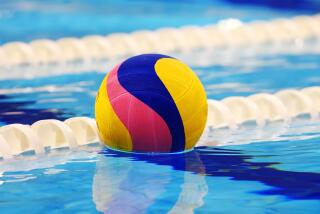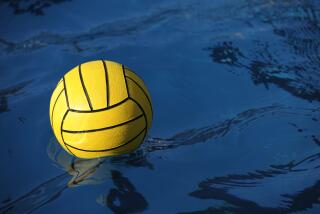It was once one of the roughest...
- Share via
It was once one of the roughest of Olympic sports. One hundred years ago, water polo rules permitted kicking, punching and eye gouging. Today, water polo is still a physical game but not as violent The top contender this year is expected to be the Italian team, which won the gold in 1992.
What We Know
After a disappointing performance from the Italian soccer team in the European Championships, the pressure on its beloved water polo team from the sporting public in Italy will certainly be hitting new levels.
The team is called Settebello, meaning the beautiful seven. Needless to say, its recent results have not been ugly. Italy won the gold in 1992 and followed with victories in the 1994 World Championships and the European Championships a year later.
Other top-medal contenders include Hungary, Spain, Yugoslavia, Croatia and the United States. Yugoslavia, winners of the gold medal in 1984 and 1988, returns after missing the 1992 Games because of United Nations and Olympic sanctions.
Although Croatia and Yugoslavia have played once without incident--in May at the U.S. Open in Nashville, Tenn.--both sides are predicting that blood will flow, if necessary, in Atlanta.
What We Don’t Know
Whether the home spectators can give the U.S. team a significant boost remains to be seen. The last time the Games were in the United States, in 1984, the Americans took the bronze.
Eight of the 13 Olympians retired from the U.S. team after a disappointing fourth-place finish in 1992. Among the returning Olympians are Chris Humbert, considered one of the world’s top two-meter men, goalkeeper and captain Chris Duplanty, drivers Mike Evans and Kirk Everist and utility man Alex Rousseau.
The Americans went undefeated at the World Cup in May, but slipped back a bit last month at a tournament in Europe, losing to Italy, tying Australia and Spain and defeating Russia.
Someone You Should Know
While it may not seem as though the 6-foot-7, 220-pound Humbert would be afraid of anything, he does admit to a fear of reptiles, specifically, snakes.
So, instead of avoiding snakes, Humbert decided to do the next best thing and bought a python from a friend. Why not confront your fears?
One problem. Humbert is running out of ideas for snake food, fearing he might have to move up to feeding the python small animals.
Still, Humbert is fearless in the pool. The 26-year-old left-hander has been the leading scorer for the United States in every major international competition since 1991, averaging three goals per game.
Something You Should Know
Lending a special urgency to matches in Atlanta, sudden-death overtime will be used in the medal rounds for the first time. Previously, overtime sessions were played to a conclusion. As before, however, ties are not broken in the preliminary round.
Rules
Team has 13 players; six players plus a goalie are in a pool at one time.
Players tread water the entire game and may not touch bottom or sides of pool.
All players, except goalie, must handle ball with only one hand.
Game has four seven-minute quarters. No timeouts.
A goal, scored by getting ball past goalie into net, is worth one point.
Fouls
Referees are on pool deck making it hard to see fouls committed under water.
Ordinary fouls: To stop an opponent from scoring in front of the goal a foul can be given, which is penalized by the award of a free throw to the opposing team, to be taken by one of its players from the point where the foul occurred.
Impeding the free movement of an opponent who is not holding the ball.
Taking ball under water when tackled.
Pushing off opponent.
Stalling.
Major fouls: Player must sit out for 20 seconds or until goal is scored. A player ejected three times is out for the game.
Kicking or striking.
Holding, sinking or pulling opponent without ball.
Misconduct or disrespect.
Four-meter foul: A free shot against the goalie is awarded from the four-meter line for pulling back on an opponent from behind when in scoring position inside the four-meter line.
Two-Meter Man
The two-meter man is similar to a center in basketball. The ball is fed into him, and he can try to score or pass to a teammate. The defender stops him from scoring by fouling him or stealing the ball.
The backhand: The defender goes for the ball on the left-hand shoulder and the two-meter man fires a backhand shot with his right hand.
The Moves
Players are only allowed inside the two-meter line if they have the ball.
Four-meters: Where penalty shots are taken.
Offense
1. A typical play can start with the point man, who feeds the ball into the two-meter man.
2. As the ball is being passed, the other field players start moving, picking off defensive players.
3. The two-meter man is fouled by his defender and is allowed a free throw. He then acts like a quarterback to find an open-field player, who shoots the ball or passes back to two-meter man. Then the cycle begins again, until there is a score or a turnover.
At a glance
Number of athletes: 156 men
Qualifications: Teams qualify based on their finish at the Water Polo World Cup or the Olympic qualifying tournament. As host country, the U.S. team automatically qualified.
Dates: July 20-24, 26-28.
Location: Georgia Tech Aquatic Center.
Olympic Pool: 1.5 - 2.0 meters deep
Sources: AP, Reuters, USA Water Polo
More to Read
Go beyond the scoreboard
Get the latest on L.A.'s teams in the daily Sports Report newsletter.
You may occasionally receive promotional content from the Los Angeles Times.







